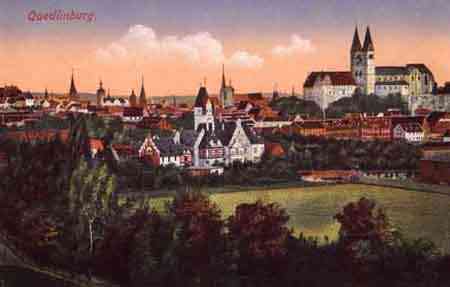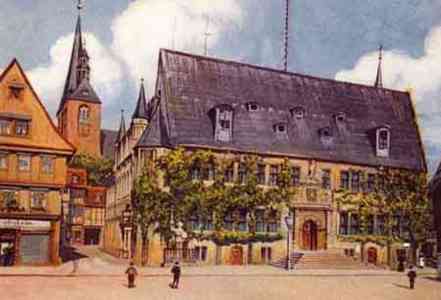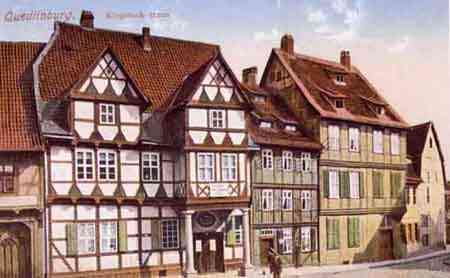|
The town of Quedlinburg |
||||||||||||||||||||||||||||
|
~ history in brief ~ Sights ~ Museums ~ Churches ~ Personalities ~ |
||||||||||||||||||||||||||||
|
|
||||||||||||||||||||||||||||
| Only a very brief outline of the history of Quedlinburg shall be presented here. When you read this, you would definitely not mind a visit of Quedlinburg. These words are written by a night watchman of Quedlinburg, who discovers no and then an hour of leisure to deal with all the long past times. | ||||||||||||||||||||||||||||
| The first important year for Quedlinburg is 922. In this year, the town was mentioned in a document, issued by Heinrich I.. So we could celebrate our first millennial on 22nd April 1922. | ||||||||||||||||||||||||||||
| From 922 to 1207, there are at least 67 visits of German emporers and kings verifiable, so that the town of Quedlinburg has the right to call themselves an Old Town of Emporers. I would like to present some dates and incidents of the history, which contributed to the development of the town until our millennium. | ||||||||||||||||||||||||||||
| I already mentioned the year 922, but already a few years later, in 929, an imperial assembly took place in Quedlinburg and at the same time the wedding of Otto I. with Editha of England. | ||||||||||||||||||||||||||||
| On 2nd July 936, King Heinrich I. died in Memleben, was taken to Quedlinburg and buried at the crypt of the Convents Church in front of the altar of St. Peter. Already a few days later, on 30th July 936, the Queen widow Mathilde founded the imperial free convent for women. | ||||||||||||||||||||||||||||
|
In 961, the relics of St. Servatius were taken ceremoniously from Maastricht to Quedlinburg. Since this time he has been being the patron saint of the Convents Church. From 966 to 999 Mathilde, the daughter of Otto I. and the grand-daughter of Heinrich I., was the first abbess of the convent. This convent was a school for noble daughters, mainly of the Saxon higher nobility. This free-worldly convent had also seat and vote at the German Imperial Diet, it was only under the emporers and the pope. From 998 to 999 abbess Mathilde was the empires administrator during the campaign of Otto III. against Rome and governed the German empire. Was Quedlinburg the capital of the German empire at this time? Another important fell in the term in office of abbess Mathilde, because in 994 Quedlinburg got the Currency, Market and Customs Legislation. This was probably the basis for the development of Quedlinburg with its many buildings of stone or timber framework. We also must not forget the foundation of the Maria’s Convent on the Muenzenberg hill in 985. It was the only convent within the town, but if I say “within the town”, it is not really right. During the time of its foundation, this convent was out of the town walls. Today it is situated in the middle of the town and belongs to the most beautiful part of Quedlinburg. |
||||||||||||||||||||||||||||
| During a stay of Emporer Lothar in Quedlinburg in 1134 Market and Customs Legislation was confirmed again for the whole empire. | ||||||||||||||||||||||||||||
| This convent had existed from 936 until the Peace of Lueneville in 1802. Then the convent fell to the Prussian state, and the convent was closed down in its function. The last abbess left Quedlinburg. | ||||||||||||||||||||||||||||
| How the convent was developing, the town of Quedlinburg was doing too, with its many small and big timber framework houses. Initially there was a row of housing estates and villages, for example Old Town, New Town with its mediaeval stamp, Westendorf around the castles hill, the former convent, which was pulled down in 1539 after the Peasants War either or after the Reformation, as the case may be. Nowadays it puts up a small with market place within Quedlinburg. In the period of industrial expansion in Germany from 1871 on and after the connection to the rail net in 1862, many of the new parts of the town developed around the old walls of the town. The expansion of the town has still not completed yet. It is being build partly within the town, but also outside of the town on the green meadow. | ||||||||||||||||||||||||||||
|
A big event for Quedlinburg was the inclusion in the list of World Cultural Heritages of UNESCO in 1994. This fact brought a fresh impetus for the entire town to all spheres, but especially to the restoration and redevelopment of the witnesses of the Middle Ages.So the town has a lot of architectural monuments and sights, for example: |
||||||||||||||||||||||||||||
| The Palace with the Collegiate Church already existed at the time of King Heinrich and has been changed during the centuries. On the Palace Hill we can find: | ||||||||||||||||||||||||||||
|
||||||||||||||||||||||||||||
|
|
||||||||||||||||||||||||||||
|
The City Hall - first mentioned in 1310 |
||||||||||||||||||||||||||||
|
||||||||||||||||||||||||||||
|
|
||||||||||||||||||||||||||||
|
Churches: |
||||||||||||||||||||||||||||
|
||||||||||||||||||||||||||||
|
|
||||||||||||||||||||||||||||
|
||||||||||||||||||||||||||||
|
|
||||||||||||||||||||||||||||
|
Towers of the town fortifications |
||||||||||||||||||||||||||||
|
||||||||||||||||||||||||||||
|
|
||||||||||||||||||||||||||||
|
Museums: |
||||||||||||||||||||||||||||
|
|
||||||||||||||||||||||||||||
|
|
||||||||||||||||||||||||||||
|
||||||||||||||||||||||||||||
|
||||||||||||||||||||||||||||
|
|
||||||||||||||||||||||||||||
|
Memories: |
||||||||||||||||||||||||||||
|
||||||||||||||||||||||||||||
|
|
||||||||||||||||||||||||||||
|
Personalities of Quedlinburg |
||||||||||||||||||||||||||||
|
||||||||||||||||||||||||||||
|
|
||||||||||||||||||||||||||||
| Quedlinburg Impressions | ||||||||||||||||||||||||||||


